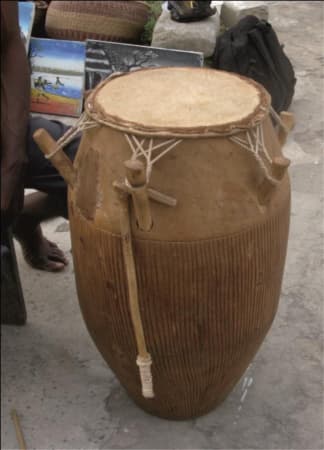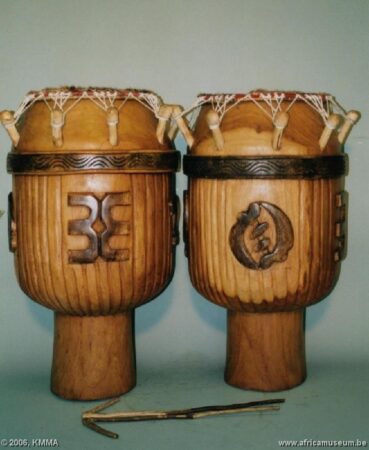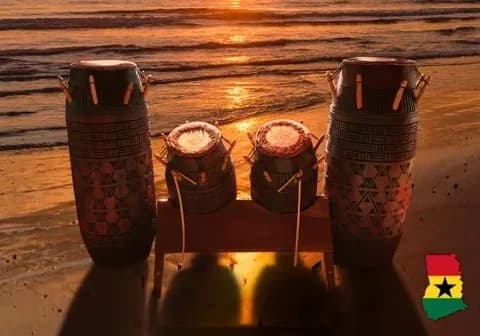Every true Ghanaian has either heard the spiritual sound of the akan talking drums or heard stories about it. The latter may be your case if your were born somewhere within the 21st Century. But there is no shame in missing the legendary sounds of any of the two prestigious drums. People still study about it and the history. Which is why it may be important to you to read through this article.
According to Ɔdomankoma-Kyerema Kwamena Pra, A Master Divine Drummer within the Cape Coast Castle who shared with us his knowledge on the African Drums. There are some very important drums among all other drums played for both cultural and spiritual purposes among the Akans.
They include the ‘Asafo kyen’- Warrior Drum and the ‘Etumpan’-The Talking Drum. All these are various kinds of talking drums used to perform different functions at different times.
What Is ‘Asafo Kyen’ or Warrior Drum

Asafo according to Ɔdomankoma-Kyerema Pra, is a group formed for the purposes of helping to develop the community. Within each Asafo group is the ‘Asafo kyen’ or Asafo drum. Since Asa means War and Fo meaning people, Asafo means war people. Thus, it can be called the warrior drum. It is a special drum which is often played to convey messages or send information across to its members and the community members at large.
The ‘Asafo kyen’ or warrior drum can also be played to entertain members of the group and the community and also used to mourn the dead.
During working hours of the Asafo group, certain poetic words are played on the ‘Asafo kyen’ or warrior drum which energises the members to work harder in order to complete the task.
How Is The ‘Asafo Kyen’ or Drum Made
According to Ɔdomankoma-Kyerema Pra, who is a Divine Master Drummer, there are some special types of trees that are used to carve the Asafo kyen or warrior drum.
There are five main trees known to him from which a proper Asafo kyen or warrior drum must be carved from and these are: ‘Odum‘ (Milicia Regia), ‘Kyendur‘, ‘Kyeramannda‘, ‘Tweneboa–Kodua‘ and ‘Mpuna‘.
Among all these the most powerful tree which when used for the ‘Asafo kyen’ carries the best spiritual vibrations which can command all spiritual beings when played is the one from the ‘Odum‘ tree.
Further, he explained the processes of how the tree is felled before it is carved into the drum. Before the tree which one intends to use for an Asafo kyen is felled, traditional prayer is performed through libation.
“Trees that are used for Asafo Kyen are not felled in a day. It is done in seven days. On each day, libation is poured before the felling continues. This is to ensure that, all the seven days spiritual energies are imbued into the tree before felling is complete for the carving to begin”.
When all these have been accomplished, the carving starts at the spot where the tree is felled before the carved pieces are carried home for final polishing to be done.
Leather Used For Asafo Kyen or Warrior Drum
Every drum has a leather which is placed on it and played either with the hand or sticks. Not all drums are covered with the same animal skin or hide.
Most drums are covered with either sheep, goat skin or cow hide or leather but the Asafo kyen or Warrior drum does not use any of these animal skins or leather.
Asafo kyen are supposed to be covered with a special skin from a Deer, ‘Dabɔ’ in Fante. Even that, it is the skin from a male ‘Dabɔ’ not a female that is used.
When fastening the animal skin to the cylindrical carved wood, seven sticks also from a special tree are used as supporting sticks to help in fastening the leather onto the wooden frame.
These sticks according to Ɔdomankoma-Kyerema Prah are called ‘Nsorowa’ from a tree called ‘Satadua’. This is what you normally see around every Asafo Kyen and that is synonymous to the seven planets of the cosmos.
After the drum has been completed, red palm oil is poured unto the animal skin used to cover the wooden frame and placed in the sun. “This shall give the Asafo kyen or warrior drum a clear sound which travels very far and carries the necessary vibrations that an Asafo kyen must have”.
The Asafo kyen or must only be played using what we call ‘Kɔtɔkorba’ which is a seven shaped stick from a particular plant called ‘Ogyama’ or that from a guava tree.
“Any tree’s seven shaped stick can be used but these two are the ones that help to produce the spiritual vibrations needed when the drum is stuck or played”.
The Master Drummer or Divine Master Drummer who plays the Asafo Kyen must always do so barefooted.
This, he explained is “To help the drummer be in tune with mother earth and all other positive spiritual vibrations around him. If one decides to wear any footwear, that may bring about negative spiritual effects” he noted.
The Atumpan

The Atumpan is one of the three Talking Drums used among the Akans.
The ‘Atumpan’ is the main talking drum of the Akan people. It is the most favoured instrument to play the bass part to accompany dancing. The ‘Atumpan’ takes the form of an open goblet drum on a base or stand. It is played in pairs, usually by a master drummer or divine master drummer using two angular or seven-shaped sticks.
‘Atumpan’ is basically a double or twin talking drums which are normally found in a Chief’s palace for the purposes of communication and honouring the Chief through appellations.
It is this same ‘Atumpan’ that is played to demand the attention of all the Chiefs subjects within the community as well as notify the community of any important event. A event such as the passing of a son or daughter of the land.
The ‘Atumpan’ plays a very key role in the celebration of festivals, ceremonies and durbars of Chiefs and all other social gatherings where the chief is present.
Normally, at social gatherings, when the chief speaks the ‘Atumpan’ is played to support and affirm the words of the Chief. This is done after every sentence from the chief at any official function.
Unlike the ‘Asafo Kyen’ or the Warrior Drum, the ‘Atumpan’ is often just static. It is the drum always found at the Chief Palace or stationed at a gathering where the chief is present.
The ‘Atumpan’ drum can also be used to assemble a gathering for any community engagement. But while the Asafo Kyen accompanies the gathering to the venue where the supposed activity must take place the ‘Etumpan’ isn’t carried along to the venue.
Apart from these, another important function of this drum, is when a chief dies, the ‘Etumpan’ is the drum used to spiritually invite all the ancestors who have occupied the stool and to inform them of what has happened to the current chief. This is critical to our tradition and an important activity performed with the ‘Atumpan’ when a Chief passes on to eternity.
One important fact to note is that, after all is said and done, the Master Drummer who invited all the ancestors must use the same ‘Atumpan’ to dismiss them after all the rituals performed have come to an end.
He added that “When the Master Drummer fails to dismiss the ancestors after inviting them, it would bring about some negative repercussion on the drummer”.
‘Atumpan’ is also played when someone dies and at funerals. This drum is played during funerals within the Akan Traditional setting.
But, after every funeral, the ‘Atumpan’ drums must be purified. The purification rite is normally performed by sprinkling a mixture of seawater and hop onto the drums after every funeral.
How The ‘Atumpan’ Are Made?
The manufacture of the ‘Atumpan’ follows the same pattern as that of Asafo Kyen. Also made from the same wood and procedure with just some minor differences.
In the case of the ‘atumpan’, the two goblets-like shape of the drum are carved from the same special wood used to manufacture the Asafo Kyen or Warrior Drum.
While the Asafo Kyen has seven sticks called ‘Nsorowa’ which are used in fastening the leather or membrane, the ‘Etumpan’ uses nine sticks in fastening it’s leather. These are used to fasten the leather or membrane to complete the drum. These sticks are conical in shape and Nine in number. Lesser number of sticks are used but the number which ignites the most potent spiritual energy when the drum is played are the nine sticks.
According to Ɔdomankoma-Kyerema Pra, anything below the number would not make the drum to be able to attract the necessary spiritual vibrations needed when it is played.
In playing the Etumpan, the drummer must always use two sticks shaped in the form of seven. These sticks are cut from the ‘Ogyama’ or quava tree. It is taboo to use your hand to play the ‘Etumpan’ drum.
The leather that is used to make the ‘Etumpan’ come from a certain antelope called ‘Dabɔ’ in the Fante language as used for the Asafo Kyen but with slight difference again.
The difference is that, because the ‘Etumpan’ is a twin drum comprising male and female properties, one of the drum is covered with the skin of a male Dabɔ and the other with a female dabɔ skin.
To address the question of why two separate antelope skins from the same type of animal are used for the ‘Etumpan’. Kwamena Pra said “Males have deeper voices while the females have higher voices. Spiritually, everything is male and female, so when the Etumpan is played, it is able to emit a harmonised sound that draws the necessary spiritual vibrations needed. That is why the male and female skins of the ‘dabɔ’ are used”.
The Initiation Ritual
Further, the Master Drummer added that, the drum needs a welcome ceremony. All the Etumpan are welcomed home with special ritual before they are played for the first time.
For the ‘Etumpan’ ritual to be successful, one must get seven local fowl eggs and the bark of a tree called ‘Ɔkrɔw’. The tree bark must be dried. Ground into powder before the seven eggs including the shells are added and mixed together.
Afterwards, the mixture is smeared around the drum. When it gets to the head of the drum, the mixture is used to draw a sign of the cross on the head of the drum.
The sign of cross made on the head of the Etumpan according to Ɔdomankoma-Kyerema Pra is to signification. That “The animal skin and the wood used to carve the drum are all from the Creator which have been assembled together to work for the Creator”.
Because they are new drums. After all these have been done, libation has to be poured using either ‘Ahei’ (which is a local drink) or Palm wine. To invoke the spirits within the drums and for the drum to respond.
“The drums shall respond by mentioning their names to the Traditional Priest and what is acceptable to them and what is a taboo as well”.
After these rituals as narrated by Ɔdomankoma-Kyerema Pra, are part of making the ‘Etumpan’ what it ought to be.
After the libation, the drums are left at a place and within seven days. The Traditional Priests shall communicate what he has been told by the spirits concerning the foods and other things that one cannot eat or do before handling the drum.
The Etumpan drums are covered with either a white or red khalico before it is played for official purposes. That is after all these rituals have been accomplished.
White represents higher spirits and red represents lower spirits.
One can only know which colour of khalico to use after the libation ritual has been performed. “Because it is after that exercise that the spirits shall reveal to the Traditional Priest the colour that is supposed to be used to wrap the drums. And he shall also notify the drummers accordingly”.
Musical Instruments in itself have always been a tool that connects us with our inner emotions and spirits. No doubt drums also come into play. With knowledge from this insight I believe you would see how important these drums are in the heritage of Ghanaians. Please do note that the pronunciations and translations are all used considering the Fante language and heritage.
Credit:DCKwameKwakye
